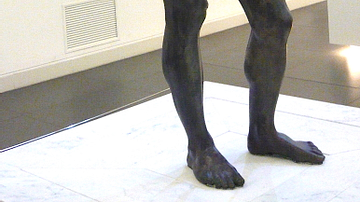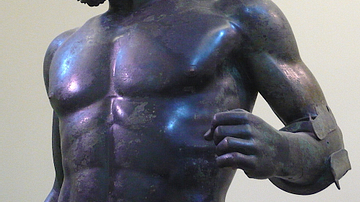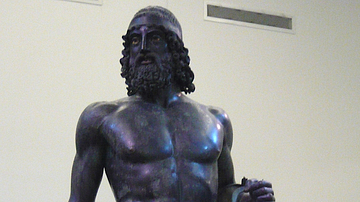Search
Search Results

Image
Riace Warrior B
The bronze Greek sculpture Riace Warrior B, c. 460-450 BCE. One of a pair known as the Riace Bronzes which were rescued from the Ionian Sea near Riace Marina, Italy in 1972 CE. The bronze figure is 1.98 m (6.5 ft.) tall. (National Archaeological...

Image
Detail, Riace Warrior A
A detail of the bronze Greek sculpture Riace Warrior A, c. 460-450 BCE. One of a pair known as the Riace Bronzes which were rescued from the Ionian Sea near Riace Marina, Italy in 1972 CE. The bronze figure is 2.05 m (6.73 ft.) tall. (National...

Image
The Riace Bronzes
The bronze Greek sculptures known as the Riace Bronzes or the Riace Warriors, c. 460-450 BCE. The statues were rescued from the Ionian Sea near Riace Marina, Italy in 1972 CE. The bronze figures are around 2 metres tall. (National Archaeological...

Image
Riace Warrior A
The bronze Greek sculpture known as Riace Warrior A, c. 460-450 BCE. One of a pair known as the Riace Bronzes which were rescued from the Ionian Sea near Riace Marina, Italy in 1972 CE. The bronze figure is 2.05 m (6.73 ft.) tall. (National...

Article
The Delian League, Part 3: From the Thirty Years Peace to the Start of the Ten Years War (445/4–431/0 BCE)
This text is part of an article series on the Delian League. The third phase of the Delian League begins with the Thirty Years Peace between Athens and Sparta and ends with the start of the Ten Years War (445/4 – 431/0 BCE). The First Peloponnesian...

Article
Battle of the Eurymedon, c. 466 BCE
The Battle of the Eurymedon (c. 466 BCE, also given as the Battle of the Eurymedon River) was a military engagement between the Greeks of the Delian League and the forces of the Achaemenid Empire toward the end of the reign of Xerxes I (r...

Definition
Cyrus the Great
Cyrus II (d. 530 BCE), also known as Cyrus the Great, was the fourth king of Anshan and the first king of the Achaemenid Empire. Cyrus led several military campaigns against the most powerful kingdoms of the time, including Media, Lydia...

Definition
Serf
Medieval serfs (aka villeins) were unfree labourers who worked the land of a landowner (or tenant) in return for physical and legal protection and the right to work a separate piece of land for their own basic needs. Serfs made up 75% of...

Definition
John Wycliffe
John Wycliffe (l. 1330-1384, also John Wyclif) was an English theologian, priest, and scholar, recognized as a forerunner to the Protestant Reformation in Europe. Wycliffe condemned the practices of the medieval Church, citing many of the...

Definition
Manorialism
Medieval European Manorialism (Manorial System) was the system where rural society was arranged around a manor house or castle on an estate. The smallest units of these estates were called manors. Free and unfree labourers here worked the...